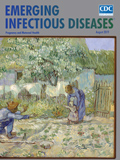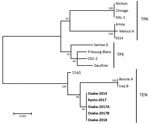
Volume 25, Number 8—August 2019
Research Letter
Bejel, a Nonvenereal Treponematosis, among Men Who Have Sex with Men, Japan
On This Page
Figures
Downloads
Article Metrics
Takuya Kawahata , Yoko Kojima, Keiichi Furubayashi, Koh Shinohara, Tsunehiro Shimizu, Jun Komano, Haruyo Mori, and Kazushi Motomura
, Yoko Kojima, Keiichi Furubayashi, Koh Shinohara, Tsunehiro Shimizu, Jun Komano, Haruyo Mori, and Kazushi Motomura
Abstract
Bejel, an endemic treponematosis caused by infection with Treponema pallidum subspecies endemicum, has not been reported in eastern Asia and the Pacific region. We report local spread of bejel among men who have sex with men in Japan. Spread was complicated by venereal syphilis.
Treponema pallidum subspecies pallidum is the causative agent of venereal syphilis. Globally, syphilis remains a disease of heterosexual persons in low-to-middle-income countries. Epidemics of syphilis among men who have sex with men (MSM) occur in high-income settings (1). Other Treponema species cause nonvenereal endemic treponematosis (also called bejel, nonvenereal syphilis, or endemic syphilis, caused by T. pallidum subsp. endemicum), yaws (T. pallidum subsp. pertenue), and pinta (T. carateum). These pathogens are morphologically and serologically indistinguishable (2). Clinically, there is little need to differentiate them. However, it is useful to differentiate them from a public health standpoint because their infection routes vary. For this purpose, a nucleic acid test is useful (3).
Bejel was eradicated in Europe in the 20th century but was prevalent there in the 16th century (4). Bejel is still prevalent in dry and hot areas, such as the Sahel region in western Africa, part of Botswana, Zimbabwe, and the Arabian Peninsula (5). The main route of transmission is direct skin-to-skin contact. Bejel can be transmitted sexually, but this route has not been studied because bejel affects mainly children. Only a few case reports of bejel have been reported in non-endemic areas since 1999, including France (3), Canada (6), and Cuba (7). Bejel in France was attributed to an imported case from Pakistan, and in Canada to an imported case from Senegal, whereas transmission in Cuba was regionalized. No patient with nonvenereal treponematosis has been reported in Japan.
In Japan, syphilis has been reemerging since 2010 (8). However, little attention has been paid to nonvenereal treponematosis. We thus conducted a molecular epidemiologic study to characterize the genotypes of T. pallidum subsp. pallidum among patients with venereal syphilis after 2011 (9).
The study protocol was approved by the Ethical Review Board of Osaka Institute of Public Health. We tested specimens from patients suspected of having or given a diagnosis of syphilis by using nucleic acid amplification tests for T. pallidum subsp. pallidum specific for the TpN47 and polA gene regions. We performed molecular genotyping of T. pallidum subsp. pallidum strains based on the nucleic acid sequences of the tp0548 and tp0856 gene regions (3,10).
Phylogenetic analysis showed that, of 58 isolates from nucleic acid test–positive specimens, 5 isolates (8.6%) were T. pallidum subsp. endemicum and different from T. pallidum subsp. pallidum and T. pallidum subsp. pertenue. We concluded that the 5 patients from whom these strains were isolated had bejel (Figure).
All 5 bejel patients were men from Japan 20–40 years of age; all were MSM. One patient was identified in 2014, another 3 in 2017, and 1 patient in 2018. Two of the patients identified in 2017 were in the secondary stage of the disease; the other 3 were in the primary stage. Clinical manifestations of the 3 patients in the primary stage were penile erosion or ulcer. The 2 patients in the secondary stage had systemic rashes and lymphadenopathy, in addition to pubic and perineal symptoms.
For serologic tests at admission, the 3 primary-stage patients showed negative results for the rapid plasma reagin test (<1.0 unit). Of these patients, 2 showed negative results of the T. pallidum latex agglutination test (<10 units) and 1 had a titer of 35.7 units. The 2 secondary-stage patients had positive results for the rapid plasma reagin test, and their T. pallidum latex agglutination test values were 2.4 × 103 and 20.8 × 103 units.
The first patient lived in Yamaguchi Prefecture. The other 4 patients lived in the Kansai area, including Osaka, Kyoto, and Hyogo Prefectures. Although the residential geographic areas were remote, the suspected locale of treponemal infection was the Kansai area, namely the city centers of Osaka and Kyoto. The 2018 patient was HIV positive. None of the patients had a history of overseas travel for a long period. All 5 isolates had a mutation conferring azithromycin resistance. The 3 patients who were followedup responded well to standard therapy with penicillin.
These data strongly suggest that T. pallidum subsp. endemicum is transmitted domestically in Japan by MSM. Our findings provide molecular epidemiologic evidence for a local spread of T. pallidum subsp. endemicum in eastern Asia and the Pacific region.
Clinical manifestations of venereal syphilis and bejel are similar, especially in the early stage for adults, which makes diagnosis difficult (7). Infectious diseases that have been historically not considered to be sexually transmitted infections (STIs), such as amebiasis, hepatitis A, and shigellosis, often show manifestations of STIs. Likewise, bejel might be changing from an endemic tropical disease to a global STI.
Treatment for venereal syphilis is also effective for bejel. For the 5 patients we report, laboratory test results showed a strong correspondence to the stage of bejel disease progression. Clinicians should be aware of the spread of nonvenereal treponematosis worldwide, especially in low-prevalence areas. Nucleic acid tests that can differentiate T. pallidum strains might be helpful (3,10). Molecular epidemiology might help determine which populations are affected and provide an effective means to prevent the further spread of treponematosis.
Dr. Kawahata is a principal research scientist at the Osaka Institute of Public Health, Osaka, Japan. His primary research interests are HIV infections, sexually transmitted infections, and syphilis.
Acknowledgment
This study was partially supported by grants-in-aid for research on HIV/AIDS from the Ministry of Health, Labour and Welfare of Japan (grants H26-AIDS-006 and H29-AIDS-007) to T.K. and a grant from the Daido Life Welfare Foundation for Regional Health and Welfare Research in 2017 to Y.K.
References
- Fenton KA, Breban R, Vardavas R, Okano JT, Martin T, Aral S, et al. Infectious syphilis in high-income settings in the 21st century.Lancet Infect Dis. 2008;8:244–53.
- Mitjà O, Šmajs D, Bassat Q. Advances in the diagnosis of endemic treponematoses: yaws, bejel, and pinta. PLoS Negl Trop Dis. 2013;7:
e2283 . - Mikalová L, Strouhal M, Oppelt J, Grange PA, Janier M, Benhaddou N, et al. Human Treponema pallidum 11q/j isolate belongs to subsp. endemicum but contains two loci with a sequence in TP0548 and TP0488 similar to subsp. pertenue and subsp. pallidum, respectively. PLoS Negl Trop Dis. 2017;11:
e0005434 . - Lipozenčić J, Marinović B, Gruber F. Endemic syphilis in Europe. Clin Dermatol. 2014;32:219–26.
- Giacani L, Lukehart SA. The endemic treponematoses. Clin Microbiol Rev. 2014;27:89–115.
- Fanella S, Kadkhoda K, Shuel M, Tsang R. Local transmission of imported endemic syphilis, Canada, 2011. Emerg Infect Dis. 2012;18:1002–4.
- Noda AA, Grillová L, Lienhard R, Blanco O, Rodríguez I, Šmajs D. Bejel in Cuba: molecular identification of Treponema pallidumsubsp. endemicum in patients diagnosed with venereal syphilis. Clin Microbiol Infect. 2018;24:1210.e1–5.
- Takahashi T, Arima Y, Yamagishi T, Nishiki S, Kanai M, Ishikane M, et al. Rapid increase in reports of syphilis associated with men who have sex with women and women who have sex with men, Japan, 2012 to 2016. Sex Transm Dis. 2018;45:139–43.
- Kojima Y, Furubayashi K, Kawahata T, Mori H, Komano J. Circulation of distinct Treponema pallidum strains in individuals with heterosexual orientation and men who have sex with men. J Clin Microbiol. 2019;57:e01148–18.
- Staudová B, Strouhal M, Zobaníková M, Cejková D, Fulton LL, Chen L, et al. Whole genome sequence of the Treponema pallidumsubsp. endemicum strain Bosnia A: the genome is related to yaws treponemes but contains few loci similar to syphilis treponemes.PLoS Negl Trop Dis. 2014;8:
e3261 .
Figure
Cite This ArticleOriginal Publication Date: 7/1/2019

No comments:
Post a Comment